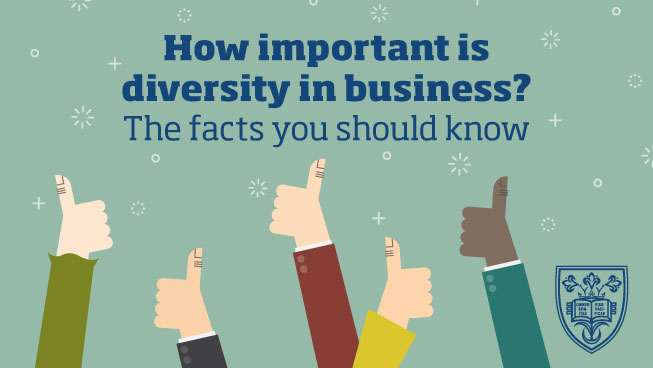March 27, 2017
How important is diversity in business? The facts you should know

Diversity is more important now than ever before, as Americans are growing more racially and ethnically diverse by the year. In fact, it’s been projected that the U.S. will not have a single racial or ethnic majority by 2055, according to the Pew Research Center.
These population trends have spurred several conversations about diversity in our schools, diversity in higher education, diversity in our government, diversity in media representation and more. But what about diversity in business?
Did you know that businesses can see increased productivity and profitability by fostering a diverse and inclusive work environment? Decades of research by organizational scientists, psychologists, sociologists, economists and demographers support the notion that socially diverse groups achieve higher levels of innovation than homogeneous ones.
We canvassed a handful of business experts to learn their take on the importance of diversity in business. But first, let’s dig into what we mean when we talk about a diverse business workforce.
What does ‘diversity in business’ actually mean?
It’s a compelling statistic to say that 80% of the members of inclusive and diverse teams view their work experience more positively and feel they work harder because of this. But it carries little traction if we don’t first divulge what we mean when we talk about diversity and inclusion in business.
“Diversity is a double-edged sword in organizational theory. Thus, it’s important to properly define diversity within organizations,” says David Youssefnia, president and founder of Critical Metrics, LLC. He suggests that diversity can be broken into two categories:
- What some refer to as capital-D Diversity refers to diverse social identities, including gender, race and sexuality.
- In contrast, lowercase-d diversity refers to diversity within employees’ resume content, such as education, experience and expertise.
“Each type of diversity impacts various aspects of the organizational culture and outcomes,” Youssefnia explains. That is to say, successful businesses should strive to achieve both within their organizations.
“The more varied your employees are, the more likely you are to reach a varied group of customers,” suggests Samar Birwadker, CEO of Good&Co. He adds that fostering diversity within a business isn’t as simple as just checking a box or meeting a quota.
“Diversity means more than just hiring women and people of color — it means hiring people from all over the world, people with different sexual orientations, people who are 50 years apart in age, people from various backgrounds and those with varying political orientations,” he explains. “When you get a unique array of people together with the common goal being to make your business a success, you’ll end up with a far more interesting and relatable product.”
The true importance of a diverse workforce
“Diversity and inclusion are critical and strategic to business success,” urges Stan Kimer, president of Total Engagement Consulting. “The interconnected global business environment is increasingly diverse.” He believes that to win the marketplace, companies must be strategic about leveraging diversity as a business advantage.
“The benefits are inarguable,” agrees Kimberly Barnes, founder of ContentPark. Using her company as a practical example, she goes on to explain, “We are creating content that will be read by all types of people. And in order to do that well, we must bring cognitive diversity — meaning diversity in the way we approach life and business.”
Developing real diversity ultimately leads to greater innovation, Barnes adds. Innovation is not only essential to a business’ present survival but also to its ability to propel itself successfully into the future.
But don’t just consider the opinions of our experts. The facts, as provided by McKinsey & Company, can speak for themselves:
- Companies in the top quartile for racial and ethnic diversity are 35 percent more likely to have financial returns above their respective national industry medians.
- Companies in the top quartile for gender diversity are 15 percent more likely to have financial returns above their respective national medians.
- In the U.S., there is a linear relationship between diversity and better financial performance.
- The unequal performance of companies in the same industry and same country implies that diversity is a competitive differentiator shifting market share toward more diverse companies.
Upon conducting the research for the above statistics, McKinsey & Company has concluded that when companies are more diverse, they become better able to win top talent and improve their customer orientation, employee satisfaction and decision making. This leads to a virtuous cycle of increasing profit.
Looking toward a more diverse workforce
“Diversity in business is absolutely paramount to success,” Birwadker maintains, and it’s clear our other business experts agree, with a host of statistics supporting this notion.
So how can you increase diversity within your own organization? Kimer suggests the process can fall into five areas:
- Recruit the very best talent from the widest possible talent pool.
- Provide an inclusive work environment so all feel welcomed and valued.
- Welcome diverse product development and service delivery ideas that will resonate with the largest range of clients and customers possible.
- Have sales and marketing efforts in place that understand the diverse marketplace and can be delivered with a level of cultural competence.
- Engage with the diverse community in which your organization exists.
Another great place to start? Keep your eye out for post-graduate business programs that draw special attention to the issues of diversity and inclusion.
For example, the MBA in Leadership and Change program at The College of St. Scholastica provides its graduate students with an abundance of coursework and discussions relating to diversity and cultural competence. They even offer an entire course dedicated to communication across cultural boundaries.
Learn more by visiting our article, “5 things you need to know about St. Scholastica’s MBA in Leadership & Change.”
Receive Program Info and Financial Aid Options
- Detailed program overview
- Personalized financial aid
- Individual admissions support

